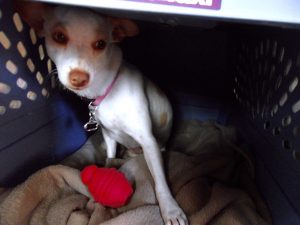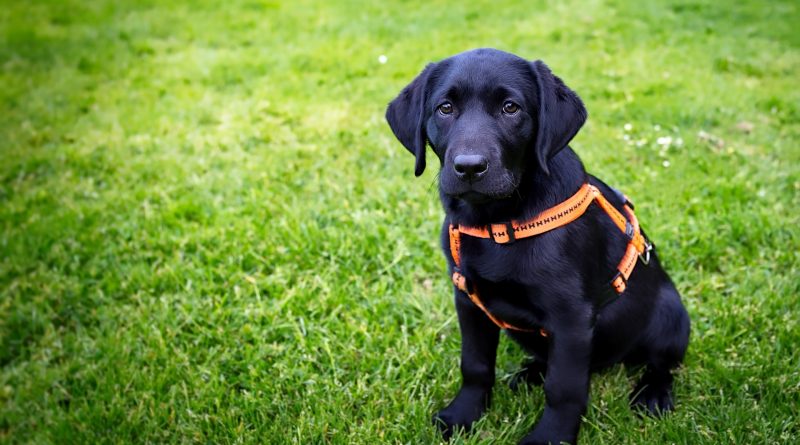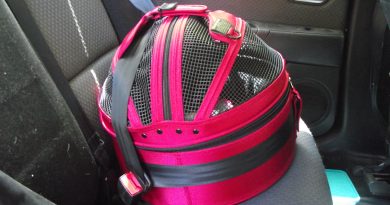Raising a Puppy in an RV Series: Crate Training and House Training
We love the freedom to travel anywhere our RV can go, getting to see so many places others only dream of, and living a much simpler life. But, when we added a puppy to that life, we moved from a simple life to a more complicated one. Fortunately, there are some tips that helped make it an easy transition.
Create a Plan
There is no doubt that puppies are cute. That, by itself, helps right away when puppy training doesn’t go as planned. Still, having a plan will help you get through the ups and downs of puppy training, especially when you live full time in an RV.
Crate training, potty training, behavior training, puppy health, and exercise are all to be taken into consideration when you get a puppy. All of these need to be planned for within the scope of RV living. It can be done!
Crate Placement Plus Training in the RV

Crates are a great tool for house training and keeping your puppy confined so he doesn’t chew up things in your RV. Before you bring home your puppy, you need to figure out what type of crate you’ll use and where in your RV will it fit the best.
How Big Should the Crate Be?
A crate for a puppy needs to be just large enough for him to stand up, lie down, and turn around in but not so large that the he can find a spot to go to the bathroom away from his bed. Dogs do not like to soil their bed and the proper crate size will help tremendously when you are potty training your pup.
Many collapsible wire crates come with a detachable divider so you can change the size of the crate as the puppy grows instead of buying a new one after each growth spurt.
Crate Placement
Placement of the pup’s crate is somewhat of a puzzle when you live in an RV. Keep in mind what furniture can be moved or removed, traffic patterns, easy access to the crate and where your puppy will be sleeping.
When we brought Cricket home, we had a smaller, plastic crate that we used for travel as well as her bed/safe space. At first we put it next to our bed so that she would feel safe when sleeping. This worked for a long time until WE got tired of hauling it back and forth from the car to the RV.

We waited until she was fully potty trained then bought a large, collapsible crate for her to spend time in when we leave her alone. Because she’s potty trained, having a really large one is no longer an issue. We’re confident she’s not going to have an accident on or near her bed.
Cricket’s also moved from sleeping in her crate overnight to sleeping in our bed. We were able to put her new, large crate into an area in the main “living room” that’s out of the way. This makes for easy traffic patterns through the RV. No more tripping on a dog crate in the middle of the night!
More Crate Placement Ideas
Other RVers have made crates out of the space under their dinette bench seats like the ones dizzydogs have made, or purchased a crate that looks like a side table like the Merry Pet 2-in-1 Configurable Crate and Gate. Some have even removed the dinette table or bunk beds completely to make room for crates or put crates on the bunk itself. Many have attached the crates permanently in the garage area of their toy hauler. You just have to decide what works best for you and your new pup.
Crate Training
Crate training your puppy can be pretty simple. The key is consistency and making the crate a positive place to be. Start by making it comfortable with a bed or blankets. Cover it to make it feel safe like a “den” (leaving enough open space for ventilation).
Leave the door open and let your puppy walk in and out of the crate on his own. Give your pup a treat when any of his paws are inside. After he feels comfortable going in and out of the crate, let him spend a few seconds inside with the door closed. Give lots of treats for calm behavior.

Work up to putting your puppy into the crate for 10 minute periods at a time to begin. Give them a treat or a stuffed rubber chew toy like a KONG puppy classic toy while they are in there.
I feed Cricket in her crate so that she will always feel like it’s a good place to be. As your puppy gets more comfortable in the crate, increase (in small increments) the time your puppy stays in the crate, always with a safe and/or stuffed chew toy.
For more information on crate training your puppy enjoy this video by Zak George:
House Training (aka Potty Training) from the RV

Now that you have your puppy accustomed to a crate it is time to use it for house training. Using a crate makes potty training so much easier!
With Cricket, we would take her out to go potty first thing in the morning. I would tell her to “go potty,” and she would go. Then I would praise her and give her a treat or take her for a little walk. After that she could come back into the RV, have some play time, then eat her breakfast.
Cricket’s House Training
Keeping her on this morning schedule helped us to predict when she would have to eliminate. What goes in must come out, right? Since she had been in a shelter most of her puppyhood, she had no schedule. When she had to potty, she would just go in her kennel in the shelter whenever she felt like it. So, since she was an older puppy, I would wait for about 2 hours after her breakfast and take her out to her “potty spot.”
Her potty spot consisted of a puppy pee pad soaked with her urine (used to clean an accident in the RV) and placed on the ground where I wanted her to go. The spot was usually about the same distance from the rear corner of our RV every time. This is the slight twist in potty training we used since we moved to a different location every two to three weeks. The constant moving would keep Cricket from knowing where to go, hence the need for the urine soaked pee pad near the same corner of our RV.
Using a Crate for House Training
Sometimes, Cricket would not “go potty” when asked. Here’s where her crate came in handy! If she wouldn’t go right away, I would simply put her in her crate for about ten to fifteen minutes, then take her back out to potty. When she went, she got lots of praise and treats. If she didn’t, I put her back into the crate and the process started all over again until we had success.
Keep a Consistent Schedule
The potty schedule continued after Cricket’s breakfast: every two hours I would take her out. The time increased to three hours for a while. Then it went up to four hours when we were certain that she could hold it that long. During this time, Cricket was teaching us the signal she gave when she started to have the urge to go.
Cricket, like most dogs, did not want to eliminate in her house (our RV.) She was upset when she would have an accident. It was NEVER intentional on her part to piddle on the floor. She simply had to go and we weren’t paying attention. After about three piddle accidents in the RV, we finally caught on and we’ve been consistent ever since.
If you want to learn the steps to potty train your pup, follow along with Zak George and a husky puppy named BB8. Keep watching even though he does strongly advertise a pet supply company.
So, if we can crate train and potty train a puppy in an RV, you can too! Make your plan and be as consistent as you can, regardless of location. You will both be happy campers when it all comes together!
Want to know what to do with all that puppy energy? Here’s the next article in our “Raising a Puppy in an RV” Series: https://tiresandtails.com/dogs/raising-puppy-rv/
[AmazonDisclaimer]
Please share your dog stories
- Have you potty trained a puppy while living in an RV?
- What tips or tricks worked for you?
Let us know in the comments below!




